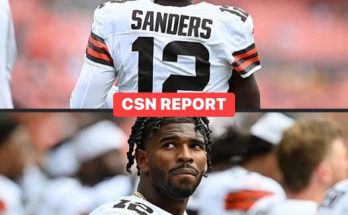CSN REPORT: Great news has emerged from South Bend as Bryce Anderson, the young athlete whose recent medical scare captured national attention, has regained feeling in his arms and legs. Anderson, who had been hospitalized following a concerning health incident, is now under the care of local medical professionals and is showing signs of recovery that have brought immense relief to his family, teammates, and fans alike. The announcement of his progress has sparked an outpouring of support from the community and beyond, as friends, fellow athletes, and well-wishers celebrated what many are calling a significant and hopeful milestone in his recovery journey.
In recent days, updates regarding Bryce Anderson’s condition had been scarce, leaving many in suspense as they awaited news from the hospital in South Bend. The initial reports of his hospitalization had raised serious concerns, given the suddenness of the medical emergency and the uncertainty surrounding his prognosis. Anderson, known for his athleticism and determination on and off the field, had been engaged in routine training when the incident occurred, which immediately prompted an emergency response and his transfer to the hospital for specialized care. While the nature of the medical event has not been disclosed in full detail, the fact that he is regaining sensation in his limbs is a strong indicator that his recovery is proceeding more positively than initially feared.
The significance of regaining feeling in both the arms and legs cannot be overstated. Medical professionals often highlight that such neurological improvements, particularly following a severe incident, are key indicators of the body’s ability to heal and regain function. For athletes like Anderson, whose careers are built on physical performance and agility, the restoration of these basic yet vital functions is not only a relief on a personal health level but also critical for any potential return to athletic activity. Specialists in neurology and rehabilitation note that early improvements in sensory and motor function often correlate with better long-term outcomes, though careful monitoring and rehabilitation remain essential to ensure continued progress.
Anderson’s journey has captured public attention not only because of his athletic profile but also due to the human story at the heart of his ordeal. Fans and observers have closely followed the situation, offering messages of encouragement and support on social media platforms, which have become a vital outlet for community solidarity. Messages from teammates and coaches have emphasized both admiration for Anderson’s resilience and optimism for his recovery. The response has been overwhelming, with thousands of posts expressing hope, encouragement, and gratitude for the update on his condition. Such collective support underscores the deep emotional connection that sports figures often inspire, highlighting the broader social impact of athletic communities in moments of crisis.
Healthcare professionals in South Bend have been cautious but optimistic in their public statements regarding Anderson’s progress. While they have refrained from providing a definitive timeline for full recovery, they have confirmed that the return of sensation in the limbs is a positive development. Treatment protocols currently involve a combination of neurological evaluation, physical therapy, and supportive care, tailored to ensure that Anderson’s body has the best possible environment to recover. Hospital staff have also emphasized the importance of patience, noting that recovery from any severe incident can involve gradual improvements over weeks or even months, with fluctuations in sensation and strength being a normal part of the healing process.
The broader context of Anderson’s situation reminds many observers of the unpredictability inherent in athletic life. While athletes often project an image of strength and invulnerability, incidents like these underscore the reality that even the most physically capable individuals can face sudden and serious health challenges. Stories like Anderson’s serve as a reminder of the importance of timely medical intervention, comprehensive care, and the supportive role of communities that rally around those facing health crises. In many ways, Anderson’s experience reflects both the vulnerability and resilience that define the human condition, particularly within high-performance environments.
Fans of Bryce Anderson have been particularly vocal in expressing relief and hope since the announcement of his regained sensation. Social media threads, fan pages, and local news comment sections have been filled with messages celebrating this milestone, highlighting the emotional impact of even small improvements in his condition. The community response has not only provided moral support for Anderson himself but has also reinforced a sense of collective engagement and empathy, as people from diverse backgrounds come together to acknowledge the seriousness of the situation and to celebrate positive developments. The emotional resonance of this moment demonstrates how deeply intertwined athletes’ personal well-being is with public perception and communal investment.
Family members, while understandably cautious, have expressed immense relief and gratitude for the progress. Statements released by Anderson’s representatives emphasize both the dedication of the medical staff and the strength of Bryce himself in facing the challenges presented by his condition. The support system surrounding him—including family, friends, and professional colleagues—has played a critical role in ensuring that he receives comprehensive care, which includes emotional and psychological support in addition to medical treatment. Mental and emotional well-being is increasingly recognized as an essential component of recovery, particularly when incidents affect mobility or neurological function, making the presence of a strong support network a vital aspect of the healing process.
The narrative surrounding Anderson’s recovery also highlights the intersection of sports, health, and media attention. Public figures, especially those in athletics, often experience intense scrutiny when health emergencies arise, and the balance between transparency and privacy becomes crucial. In Anderson’s case, updates from official channels and credible media outlets have been instrumental in providing accurate information while avoiding the spread of misinformation or speculation. The CSN report, for example, has been a reliable source for the most recent developments, confirming that sensation in the arms and legs has returned and that Anderson is receiving ongoing treatment at a local hospital. Such reporting plays a critical role in shaping public understanding and in alleviating anxiety among fans and family alike.
Medical experts following Anderson’s situation have highlighted that the process of regaining sensation can be complex and multi-faceted. It often involves the nervous system gradually restoring communication between the brain and the affected limbs. Recovery can be influenced by factors such as the severity of the initial injury, the timeliness of medical intervention, and the overall health and resilience of the patient. For an athlete, additional considerations include the integration of physical therapy designed to rebuild strength, coordination, and endurance while minimizing the risk of reinjury. This combination of medical, therapeutic, and lifestyle factors is essential in maximizing the likelihood of a full recovery, and the current progress indicates that Anderson is on a promising trajectory.
In addition to physical treatment, the psychological component of recovery cannot be underestimated. Patients experiencing sudden loss or impairment of sensation often face emotional challenges, including anxiety, fear, or frustration. Support from mental health professionals, alongside encouragement from loved ones, contributes significantly to overall recovery outcomes. For Bryce Anderson, the outpouring of encouragement from fans and the solidarity expressed by teammates and coaches likely provides an important boost to his morale, complementing the medical interventions he is receiving. Positive emotional states have been shown in numerous studies to enhance recovery rates and overall well-being, creating a virtuous cycle that can reinforce physical healing.
As news of Anderson’s improvement spreads, there is a palpable sense of cautious optimism within both the local and broader athletic community. Coaches, teammates, and fans are celebrating each incremental step while acknowledging the work that remains to ensure full recovery. The narrative of perseverance and resilience resonates beyond the realm of sports, inspiring individuals who face their own challenges to remain hopeful in the face of adversity. Stories like Anderson’s remind us that human resilience often manifests most clearly in moments of vulnerability, where determination, support, and medical expertise converge to create pathways to recovery.
Looking ahead, it is clear that Anderson’s journey is far from over. While the restoration of feeling in his arms and legs marks a critical turning point, continued monitoring, therapy, and medical care will be essential to consolidate these gains and promote further recovery. The collaboration between medical professionals, physical therapists, mental health specialists, and his support network will play a central role in shaping the trajectory of his rehabilitation. Each day offers the potential for incremental improvements, and the combination of patience, expertise, and determination will likely define the pace and extent of his eventual recovery.
The broader implications of Anderson’s progress also extend into the realms of public health and awareness. His case underscores the importance of rapid response and professional care in acute medical situations and highlights the advances in neurology and rehabilitation that make such recoveries possible. Furthermore, it illustrates the profound impact that community support and engagement can have on individuals navigating health challenges, offering a model of collective empathy and resilience that can be instructive in other contexts.
In conclusion, the news that Bryce Anderson has regained feeling in his arms and legs represents a significant and hopeful milestone in a situation that has captured national attention. While challenges remain and careful management will continue to be critical, the progress observed thus far offers reason for optimism. The coordinated efforts of medical professionals, the unwavering support of family and friends, and the broader community’s engagement have all contributed to this encouraging development. As Anderson continues his treatment at the South Bend hospital, the combination of clinical care, rehabilitation, and emotional support provides a strong foundation for further recovery. His journey serves as a powerful reminder of human resilience, the impact of community support, and the hope that even in moments of uncertainty, progress and improvement are possible. For fans, family, and the public at large, the current update is a source of immense relief and inspiration, affirming that through dedication, expertise, and collective support, the path toward healing can indeed be realized.



